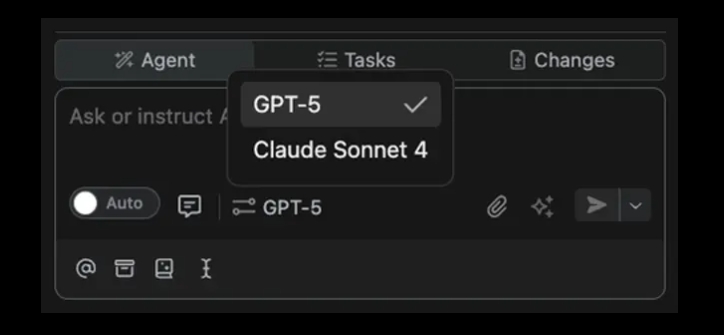Augment announced the launch of its latest artificial intelligence model, GPT-5, and introduced the model selector feature for the first time, allowing users to choose between Claude Sonnet4 and GPT-5. This innovative move marks a significant advancement for Augment in the field of artificial intelligence, offering users more flexibility and choice.
During internal testing over the past few weeks, Augment conducted rigorous comparative tests on both models, involving coding tasks such as single-file editing, multi-file refactoring, test generation, and error fixing in large codebases. The test results showed that while Claude Sonnet4 slightly outperformed in speed, favoring quick and direct responses, GPT-5 demonstrated more caution and thoroughness when handling complex tasks, including more detailed reasoning and asking clarifying questions in ambiguous situations.

In terms of preference rate, GPT-5 slightly led with about 47% compared to Claude Sonnet4's approximately 44%, while both had a tie rate of 4%. GPT-5 performed stronger in cross-file reasoning and dependency parsing, whereas Claude Sonnet4 was faster at handling small or medium changes. In code quality reviews, Claude Sonnet4's comments were more concise, focusing on main changes, while GPT-5's comments were more comprehensive, covering edge cases.
Augment decided to launch the model selector to give users the choice between thoroughness and speed. Some users may prefer precision and coverage of edge cases, while others may prefer fast iteration. Additionally, if a model provider experiences delays or quality fluctuations, users can switch models at zero cost, providing additional flexibility to their workflow. At the same time, user choices provide valuable feedback to Augment, helping with future model optimization and behavioral adjustments.
Although Claude Sonnet4 remains Augment's default model, GPT-5 offers users another option, especially when different approaches are needed for tasks. Augment will continue to monitor the usage distribution between the two models, the types of tasks where GPT-5 adoption has surged, and the trends in latency and failure patterns over time. User feedback is crucial in shaping the next round of adjustments.
